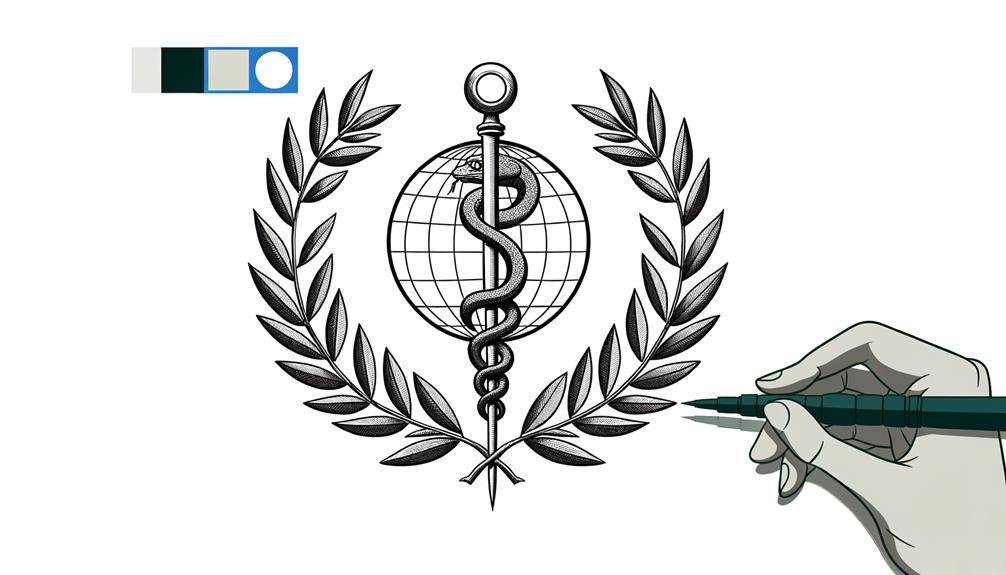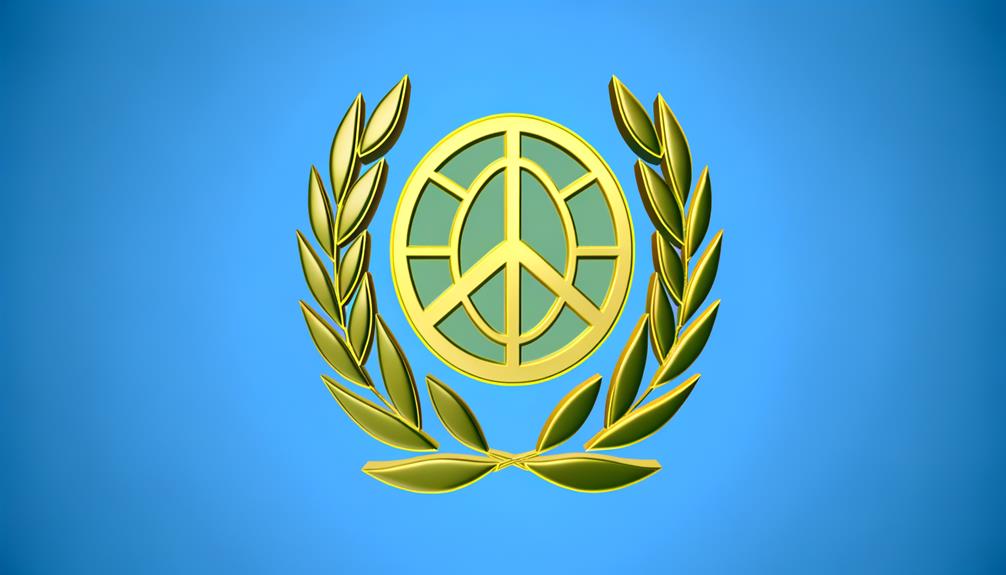World Health Organization Symbol Meaning?
The World Health Organization (WHO) symbol, established in 1948, represents a confluence of global health principles. It features the Rod of Asclepius, a traditional symbol of healing rooted in Greek mythology, illustrated with a serpent symbolizing rejuvenation.
The emblem also includes a world map encircled by olive branches, emphasizing international cooperation, peace, and unity in public health efforts. The symbol's design underlines WHO's mission to promote global health equity and support medical ethics.
Additionally, the emblem's evolution reflects ongoing commitment to addressing global health challenges in an adaptable and recognizable form, highlighting its enduring relevance. Explore further to understand its detailed significance.

Key Takeaways
- The WHO symbol features a world map, olive branches, and a central staff symbolizing global health unity.
- The Rod of Asclepius in the emblem represents healing and medicine, rooted in ancient Greek mythology.
- The snake entwined on the staff signifies healing, rebirth, and the ethical principles of the medical profession.
- Olive branches symbolize universal commitment, reconciliation, and harmony, aligning with WHO's mission.
- The WHO emblem emphasizes international cooperation, addressing health disparities, and equitable access to healthcare.
Origins of the WHO Symbol

The origins of the World Health Organization (WHO) symbol date back to 1948, when the organization was established and a visual identity was needed to encapsulate its mission and values.
The design process was methodical, focusing on creating an emblem that would symbolize global health unity. The emblem features a world map flanked by olive branches, symbolizing peace, and a central staff, which underscores medical authority.
The incorporation of these elements was deliberate, aiming to convey an image of international cooperation in the field of public health. The choice of the world map reflects WHO's global reach, while the olive branches signify the organization's commitment to peace and health for all nations, underscoring its foundational values and objectives.
The Rod of Asclepius
The Rod of Asclepius, an emblem featuring a serpent coiled around a staff, holds significant symbolism rooted in ancient Greek mythology. This symbol is historically associated with Asclepius, the deity of healing and medicine, establishing a profound connection to the medical profession's legacy.
Its adoption by the World Health Organization underscores the enduring relevance of these ancient principles in contemporary healthcare practices.
Symbolism and Mythology
Rooted in ancient Greek mythology, the Rod of Asclepius symbolizes healing and medicine. It features prominently in the World Health Organization's emblem as a reflection of its commitment to global health. This symbol is a staff entwined by a single serpent and is associated with Asclepius, the Greek deity of healing and medicine.
Asclepius was revered for his ability to restore health and was often depicted holding this rod. The serpent, shedding its skin, signifies renewal and rejuvenation, key themes in medical practice. Unlike the Caduceus, which is mistakenly used in similar contexts, the Rod of Asclepius directly embodies medical ethos.
The WHO's adoption of this symbol underscores its foundational mission to heal and promote well-being worldwide. It grounds its efforts in a timeless emblem of care.
Medical Profession Legacy
Building upon its mythological roots, the Rod of Asclepius has become a universally recognized symbol in the medical profession, representing the enduring legacy of healing practices and the ethical imperatives that guide healthcare professionals.
Emerging from the ancient Greek deity Asclepius, associated with medicine and healing, the rod entwined with a single serpent epitomizes the dual nature of medical practice: the potential to heal and the ethical responsibility to do no harm.
Historically, the serpent symbolizes rejuvenation, as it sheds its skin, while the staff represents authority and support. This emblem underscores a commitment to continuous learning, patient care, and adherence to professional standards, thereby anchoring the medical community's dedication to human well-being and scientific advancement.
Symbolism of the Snake

Tracing its origins to ancient mythology and medical traditions, the snake in the World Health Organization symbol represents healing, rebirth, and the dual nature of medicine as both a life-saving and potentially dangerous practice.
Historically, the snake is linked to Asclepius, the Greek god of medicine, whose staff entwined with a snake remains a ubiquitous emblem of medical practice. This symbolism underscores the regenerative capabilities of medicine, as snakes shed their skin and emerge renewed.
Additionally, the serpent's venom, while harmful, can also be harnessed for therapeutic purposes, reflecting medicine's potential for both harm and healing. The choice of the snake encapsulates the delicate balance medical professionals navigate in their pursuit of health improvement and disease eradication.
The World Map Element
The inclusion of the world map in the World Health Organization's symbol underscores the principles of symbolic world unity and geographical inclusivity.
This element highlights the organization's commitment to addressing health issues on a global scale, ensuring no region is overlooked.
Symbolic World Unity
Central to the World Health Organization's emblem, the world map signifies global inclusivity and the collective responsibility of all nations in the pursuit of health equity. This map, encompassing all continents, visually asserts that health is a universal right transcending borders.
By representing the globe without political demarcations, it emphasizes unity and shared commitment amongst member states. The map's central position in the emblem underlines the WHO's mission to foster international cooperation and mobilize resources to address diverse health challenges.
It serves as a constant reminder that health crises know no boundaries, necessitating a concerted global effort. This unity is foundational for coordinated responses to pandemics, ensuring that advancements in health are accessible to every corner of the world.
Geographical Inclusivity Significance
Building on the concept of symbolic world unity, the geographical inclusivity represented by the world map element in the WHO emblem underscores the organization's commitment to addressing health disparities across all regions. This element signifies a global approach, emphasizing that health issues are not confined to any single nation or continent. The inclusion of the entire world map illustrates WHO's dedication to equitable healthcare access, regardless of geographical location.
| Region | Health Initiative | Impact |
|---|---|---|
| Africa | Malaria Eradication Programs | Reduced mortality rates |
| Americas | Vaccination Campaigns | Increased immunization |
| Europe | Mental Health Support | Improved well-being |
| Southeast Asia | Maternal Health Improvement | Lowered maternal deaths |
| Western Pacific | Tobacco Control Policies | Decreased smoking rates |
This global perspective is instrumental in fostering all-encompassing health solutions.
Global Health Representation
Emphasizing the interconnectedness of global health, the world map element in the WHO emblem symbolizes the organization's all-encompassing approach to addressing diverse health challenges across different regions. This emblematic representation underscores the need for:
- Global Surveillance: Monitoring and responding to health threats worldwide.
- Collaborative Research: Facilitating international research partnerships to tackle diseases.
- Equitable Resource Distribution: Ensuring all regions have access to necessary health resources.
- Policy Coordination: Harmonizing health policies across borders for cohesive action.
Each element reflects WHO's mission to transcend geographic boundaries, fostering a unified response to health crises.
Olive Branches and Peace

The olive branches encircling the World Health Organization's emblem symbolize a universal commitment to promoting peace and health, drawing on ancient traditions where the olive branch represented reconciliation and harmony.
This emblematic choice aligns with the WHO's mission to foster global cooperation in health-related matters, underscoring the intrinsic link between health and peace.
Historical evidence indicates that olive branches have been used as symbols of peace since ancient Greece and Rome, where they were tokens of truce and goodwill.
By adopting this symbol, the WHO conveys its dedication to mitigating conflicts and fostering a harmonious global environment conducive to health improvement.
This symbolism reinforces the organization's role in uniting nations towards common health objectives and peaceful coexistence.
The Blue and White Palette
Drawing from a tradition of using color symbolism to convey meaning, the blue and white palette of the World Health Organization's emblem reflects the values of trust, peace, and impartiality that underpin its mission.
Blue is widely recognized for evoking a sense of trust and reliability, essential qualities for a global health authority. White signifies purity and neutrality, reinforcing the WHO's commitment to unbiased and equitable healthcare.
Key aspects of the color symbolism include:
- Trust and reliability: Blue's association with stability and dependability.
- Peace and calm: Blue's calming effects, promoting peaceful resolutions.
- Purity and neutrality: White's representation of impartiality in health initiatives.
- Global unity: The combination of blue and white underscores international cooperation and harmony.
This thoughtful color choice underscores the WHO's foundational principles.
Symbol's Evolution Over Time

Building upon its foundational color symbolism, the World Health Organization's emblem has undergone several modifications since its inception, reflecting historical contexts and evolving global health priorities.
Initially adopted in 1948, the emblem featured a staff with a snake entwined, a universally recognized symbol of medicine.
Over the years, slight adjustments were made to enhance visual clarity and adaptability across various media. For instance, the globe's representation was refined to underscore the WHO's worldwide mandate.
During the late 20th century, the emblem was streamlined to conform to modern design sensibilities, ensuring it remained both relevant and instantly recognizable in a rapidly changing world.
Each iteration serves as a tribute to the WHO's commitment to adapting while maintaining its core mission.
Global Health Representation
Global health representation within the World Health Organization's emblem underscores the organization's universal commitment to addressing health challenges across diverse populations and regions.
The emblem, featuring a world map and a serpent-entwined staff, symbolizes a holistic approach to health.
This representation highlights four key aspects:
- Inclusivity: Every nation is depicted, emphasizing WHO's mandate to serve all.
- Unity: The global map fosters a sense of collective responsibility among member states.
- Health as a Right: The emblem reinforces the principle that health is a fundamental human right.
- Global Reach: The worldwide map signifies WHO's extensive influence and operational scope.
Through these elements, the emblem conveys WHO's dedication to achieving equitable health outcomes internationally.
Emblem's Role in Advocacy

The World Health Organization's emblem serves as a powerful advocacy tool by visually reinforcing the organization's commitment to global health initiatives and the universal right to health care.
The emblem, featuring the United Nations symbol and a staff with a serpent, invokes the ancient Greek symbol of medicine, the Rod of Asclepius, fostering trust and recognition. This symbolic representation is leveraged in campaigns to rally international support and mobilize resources.
Empirical studies suggest that such emblematic representations enhance public engagement and bolster credibility. Analytically, the emblem's consistent use across various media strengthens the WHO's messaging, ensuring that its advocacies resonate globally.
The emblem, hence, is not merely decorative but integral to the WHO's strategic communication and advocacy efforts.
Conclusion
The World Health Organization's emblem intricately combines historical and symbolic elements such as the Rod of Asclepius, the snake, the world map, and olive branches. These components collectively represent health, global unity, and peace.
Despite critiques that symbols may lack direct impact on health outcomes, the emblem's enduring presence underscores its significant role in global health advocacy and representation. The emblem's thoughtful design continues to reinforce WHO's mission and values in the international community.





